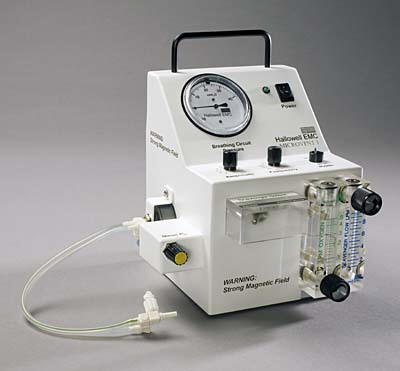Part Description: 000A3760 - MicroVent 1

A ventilator capable
of providing ventilatory support for the
smallest animals you are capable of
ventilating.
If you don't think you can intubate mice,
just look into our recently released Rodent
WorkStand and Intubation Packs. The
WorkStand holds the animal in a stable,
position that is comfortable for your
technician. The intubation packs, a Rat Pack
and a Mouse Pack, hold everything you need
to directly visualize and quickly intubate
with a minimum amount of trauma. A short
instructional video is also provided along
with numerous still photos for clarification
of the procedure.
The MicroVent 1 is a dual mode ventilator.
It will operate to deliver standard
intermittent positive pressure ventilation (IPPV)
or it will operate to deliver high frequency
oscillatory ventilation (HFOV). The entire
breathing system has a volume of less than
1cc. There are just four parameters to
control, Oxygen flow, Frequency (breaths per
minute), Amplitude (tidal volume) and Mean
Airway Pressure (Mean Paw).
In operation a small flow of fresh gas, in
the range of 50-100ml/min, is set. This gas
can be oxygen as provided by the built-in
flow meter or any mixture of gases you
provide from an external source. This gas
may flow through an anesthetic vaporizer if
you desire using gas anesthetics, then on to
the breathing system where it passes the
patient connection, flows through an open
needle valve and on to your scavenging
system as required. The animal may breathe
spontaneously from this stream of gas as it
passes the patient connection at all times.
The needle valve is used to adjust Mean Paw
as seen on the pressure manometer. As the
valve is closed, gas flow is restricted
causing pressure in the breathing system and
thus in the animal's lungs to increase. This
Mean Paw will maintain the expanded lungs
permitting continuous gas exchange with a
minimum of atelactatic alveoli.
The breathing system is also connected to a
glass cylinder containing a floating puck,
which is set in motion as per the settings
for frequency and amplitude. In IPPV mode
the frequency selectable ranges from 75 to
240 breaths per minute (BPM). The tidal
volume (TV) deliverable is from zero to
10ml. This does not limit the usefulness of
the MicroVent 1 to extremely small animals.
A switch to HFOV mode changes the frequency
range to 750 to 2400 "breaths" or more
accurately cycles per minute. The "tidal
volume" during HFOV is generally an order of
magnitude less than it would be during IPPV
and is now used to set up an oscillation of
the molecules of gas from the breathing
system down to the alveoli. This oscillation
helps promote the diffusion of the different
gasses in the system. There is a gradient in
the partial pressures of oxygen and
anesthetic gas in the system from a peak
where the fresh gas flows past the patient
connection to a low in the alveoli where the
concentrations have been decreased by
patient uptake. There is also a gradient in
the partial pressure of carbon dioxide in
the system from a high in the alveoli to a
low in the fresh gas stream. The oxygen and
anesthetic molecules continually migrate
toward the alveoli while the carbon dioxide
continually migrates toward the fresh gas
stream as they all seek to come into
equilibrium within the system.
The oscillations are superimposed on the set
Mean Paw, "all" the alveoli are held open in
virtually a steady state as the frequency is
very high and volume of the oscillations is
minuscule. The animal now only vibrates
slightly. Gas exchange is accomplished by
the diffusion of molecules as motivated by
the difference in pressure gradients. No
longer do you have the gross movement of the
respiratory cycle so distracting to the
microsurgeon. The animal just lays there as
gas exchange proceeds and the operation
proceeds uninhibited by movement within the
patient.
In addition, depending on the amplitude of
each cycle, a value of resulting continuous
positive airway pressure, CPAP, can be
observed on the pressure manometer. This
feature naturally allows and virtually
assures that the operator will be
implementing lung protective strategies as
described by Amato and Ranieri, et al. The
alveoli are no longer collapsing on
expiration then snapping open again as they
expand with each breath. This condition has
been shown to cause damage to the alveolar
epithelium and endothelium.
Incorporated into the MicroVent 1 is a
system that allows you to connect it either
directly to vacuum or an active or a passive
scavenging system. Placing the Scavenger
Select switch in the Active/Passive position
directs the waste gasses directly to the
scavenging port where you can connect a
charcoal canister or an active system that
already has a scavenging interface valve in
place. Switching to the Vacuum position
directs the gasses into an internal open
interface system allowing you to connect a
vacuum line directly to the scavenging port.
In this case the scavenging flow rate is
then adjusted on the flow meter on the front
panel.